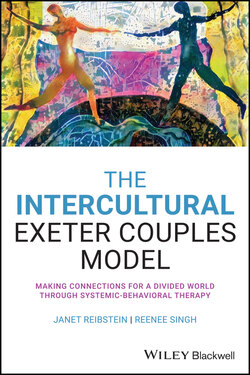Читать книгу The Intercultural Exeter Couples Model - Reenee Singh - Страница 9
THE INTERVENTIONS OF THE INTERCULTURAL EXETER MODEL
ОглавлениеMany of the interventions that are made within the adapted EM to fit intercultural work utilize the original methods, but direct the therapists to asking specific questions, using them around culture. However, just as we ask “what is the presenting problem” so that we can clearly delineate the maintenance cycle of that problem (e.g., “depression” with “depressive symptoms” at the top of the maintenance cycle), the IEM explicitly starts with “what is an intercultural couple?” Is this couple one which is facing issues that arise or are colored by being from different cultures? Sometimes the couple self‐define as “intercultural,” and sometimes the answer to this question is obvious, at face validity: the couple clearly come from different cultures or faith. But sometimes the answer is not obvious: sometimes intercultural couples might appear to be from the same culture, but because an earlier, different, generation's very strong influence, for instance, has dominated in one member's upbringing but not the other's, a different culture is having a real but not necessarily clearly observable impact. Or sometimes having been raised even partially within a different country or education system, or coming from a stronger versus a weaker faith system within the families‐of‐origin, can mean there are not obvious but still very strong and active cultural differences playing out within a couple.
The central theme in interculturally influenced therapy is to create a shared meaning to the extent that it is possible, while tolerating the differences. To achieve this we use two particular interventions designed to address culture, but also we build questions from interventions within the EM to access cultural ideas and potential tensions or dilemmas.
These are such questions as what is the meaning of home, for instance, or the loss of home for displaced cultures; or the important but different and differently valued practices of religion and culture; or the beliefs of religion and culture associated with distress or mental health difficulties; or experiences of racism, disadvantage, and expectations of protection; or of differences in parenting styles and ways of relating to extended families. These are now, through the development of the intercultural part, specifically built into the extant EM interventions. For example, the IEM will be asking therapists to help couples explore what is the “script” around mental health or their present distress, within each of the cultures, or, while designing a family genogram the therapist will be asking about such things.
But in addition to building specificity within the existing interventions, there are two specifically culturally focused methods that we also use. These are discussed in the following sections.
